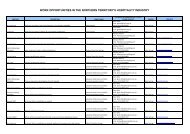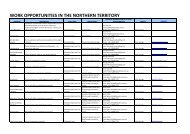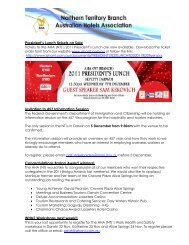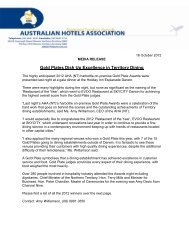the Northern Territory's lifestyle magazine. - Australian Hotels ...
the Northern Territory's lifestyle magazine. - Australian Hotels ...
the Northern Territory's lifestyle magazine. - Australian Hotels ...
Create successful ePaper yourself
Turn your PDF publications into a flip-book with our unique Google optimized e-Paper software.
fresh <strong>lifestyle</strong>s Australia’s Nor<strong>the</strong>rn Territory The NorTherN TerriTory: A brieF hisTory<br />
22<br />
discover<br />
Waves of o<strong>the</strong>r migrants followed<br />
later, enticed by jobs in pearling,<br />
pastoralism and o<strong>the</strong>r emerging<br />
industries, and <strong>the</strong> chance to make<br />
a new start in a new frontier.<br />
honour it.<br />
Darwin was founDeD as ausTralia’s mosT<br />
norTherly porT in 1869, anD iTs populaTion<br />
surgeD afTer golD was DiscovereD aT nearby<br />
pine creek in 1871.<br />
World War II put <strong>the</strong> town on <strong>the</strong> map<br />
as a major allied military base. Darwin<br />
was devastated again on 24 December<br />
1974 when Cyclone Tracy swept across<br />
<strong>the</strong> coast. The city was rebuilt with much<br />
improved construction codes and is a<br />
modern, landscaped metropolis today.<br />
The Macassans who sailed down from<br />
<strong>the</strong> Spice Islands on <strong>the</strong> trade winds<br />
to ga<strong>the</strong>r prized trepang are thought<br />
to have been <strong>the</strong> first non-Indigenous<br />
people to set foot on Nor<strong>the</strong>rn Territory<br />
soil. Dutch explorer William Jootszoon<br />
van Colster recorded <strong>the</strong> first official<br />
sighting from his tallship Arnhem in<br />
1623 – but <strong>the</strong> Macassans and o<strong>the</strong>r<br />
seafarers are thought to have visited<br />
long before <strong>the</strong>n.<br />
The 1880s gold discoveries lured an<br />
influx of Chinese fortune-seekers and<br />
Malay, Filipino and Japanese divers<br />
were brought in to collect mo<strong>the</strong>r-ofpearl<br />
shell. Greek people also came in<br />
large numbers and, toge<strong>the</strong>r with <strong>the</strong>ir<br />
fellow European and Asian immigrants,<br />
helped create <strong>the</strong> multicultural city that<br />
Darwin is today.<br />
Explorer John McDouall Stuart became<br />
<strong>the</strong> first explorer to cross Australia<br />
from south to north, paving <strong>the</strong> way for<br />
construction of <strong>the</strong> Overland Telegraph<br />
line. When completed in 1872, it<br />
provided Australia’s first communications<br />
link with <strong>the</strong> outside world.<br />
It also opened <strong>the</strong> way for pastoralists to<br />
take up leases in Central Australia – but<br />
it was <strong>the</strong> discovery of alluvial gold at<br />
Arltunga to <strong>the</strong> east of Alice Springs in<br />
1887 that provided <strong>the</strong> impetus for <strong>the</strong><br />
region’s population boom.<br />
Tennant Creek took its name from <strong>the</strong><br />
nearby watercourse named in 1860 by<br />
John McDouall Stuart to acknowledge<br />
<strong>the</strong> financial help he received from South<br />
<strong>Australian</strong> pastoralist John Tennant.<br />
Ka<strong>the</strong>rine developed with <strong>the</strong> arrival<br />
of <strong>the</strong> Overland Telegraph Line and a<br />
new telegraph station in 1872. In 1879,<br />
after good reports from Stuart and o<strong>the</strong>r<br />
explorers, Alfred Giles and Alfred Woods<br />
brought stock to <strong>the</strong> district and built<br />
‘Spring Vale’ homestead with a view to<br />
establishing a pastoral empire.<br />
World War II put <strong>the</strong> town on <strong>the</strong> map<br />
as a major allied military base for troops<br />
fighting <strong>the</strong> Japanese in <strong>the</strong> Pacific.<br />
More than 200 Defence personnel and<br />
civilians perished when <strong>the</strong> Japanese<br />
bombed Darwin on 19 February 1942.<br />
Today travellers can see evidence of<br />
Darwin’s World War II history at a variety<br />
of preserved sites including ammunition<br />
bunkers, airstrips and oil tunnels in and<br />
around <strong>the</strong> city.<br />
www.ntl.nt.gov.au<br />
www.darwintours.com.au<br />
www.darwinsairwar.com.au<br />
23<br />
1863<br />
briTain vesTeD conTrol of The TerriTory in<br />
souTh ausTralia<br />
1911<br />
souTh ausTralia relinquisheD conTrol To The<br />
commonwealTh governmenT<br />
1 july 1978<br />
<strong>the</strong> territory wAs grANted self-goverNmeNt






